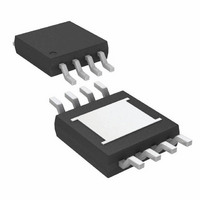LT3505EMS8E#PBF Linear Technology, LT3505EMS8E#PBF Datasheet - Page 9

LT3505EMS8E#PBF
Manufacturer Part Number
LT3505EMS8E#PBF
Description
IC REG SW STP DWN 1.2A 8-MSOP
Manufacturer
Linear Technology
Type
Step-Down (Buck)r
Datasheet
1.LT3505EDDPBF.pdf
(24 pages)
Specifications of LT3505EMS8E#PBF
Internal Switch(s)
Yes
Synchronous Rectifier
No
Number Of Outputs
1
Voltage - Output
0.78 ~ 33.8 V
Current - Output
1.2A
Frequency - Switching
200kHz ~ 3MHz
Voltage - Input
3.6 ~ 36 V
Operating Temperature
-40°C ~ 85°C
Mounting Type
Surface Mount
Package / Case
8-MSOP Exposed Pad, 8-HMSOP, 8-eMSOP
Dc To Dc Converter Type
Step Down
Pin Count
8
Input Voltage
36V
Output Voltage
0.78 to 33.84V
Switching Freq
200 TO 3000KHz
Output Current
1.2A
Package Type
MSOP EP
Output Type
Adjustable
Switching Regulator
Yes
Line Regulation
0.007%/V(Typ)
Mounting
Surface Mount
Input Voltage (min)
3.6V
Operating Temp Range
-40C to 85C
Operating Temperature Classification
Industrial
Lead Free Status / RoHS Status
Lead free / RoHS Compliant
Power - Output
-
Lead Free Status / Rohs Status
Compliant
Available stocks
Company
Part Number
Manufacturer
Quantity
Price
APPLICATIONS INFORMATION
FB Resistor Network
The output voltage is programmed with a resistor divider
between the output and the FB pin. Choose the 1% resis-
tors according to:
R2 should be 20k or less to avoid bias current errors.
Reference designators refer to the Block Diagram.
Input Voltage Range
The input voltage range for LT3505 applications depends
on the output voltage, on the absolute maximum ratings
of the V
switching frequency.
The minimum input voltage is determined by either the
LT3505’s minimum operating voltage of 3.6V, or by its
maximum duty cycle. The duty cycle is the fraction of
time that the internal switch is on and is determined by
the input and output voltages:
where V
(~0.4V) and V
(~0.4V at maximum load). This leads to a minimum input
voltage of:
with DC
The maximum input voltage is determined by the abso-
lute maximum ratings of the V
constant-frequency operation, the maximum input voltage
is determined by the minimum duty cycle requirement.
As the input voltage increases, the required duty cycle
to regulate the output voltage decreases. The minimum
duty-cycle is:
DC
R
DC
MIN
V
IN MIN
1
=
(
=
= f
MAX
R
D
IN
V
2
SW
IN
is the forward voltage drop of the catch diode
)
V
and BOOST pins, and on the programmed
=
= 1 – f
0 78
OUT
–
• t
V
SW
.
V
OUT
V
OUT
ON(MIN)
DC
SW
is the voltage drop of the internal switch
+
V
MAX
SW
V
+
+
–
D
V
1
/8.33, where f
V
D
D
–
V
D
+
IN
V
SW
and BOOST pins. For
SW
is in MHz.
where f
the worst-case minimum on-time in seconds. The minimum
on-time of the LT3505 is a strong function of temperature.
The typical performance characteristics section of the
datasheet contains a graph of minimum on-time versus
temperature to help determine the worst-case minimum
on-time for the intended application.
If the input voltage is high enough that the duty-cycle
requirement is lower than DC
skipping mode. Specifi cally, the onset of pulse-skipping
occurs at:
V
Above V
to control the inductor current and regulate the output
voltage, possibly producing a spectrum of frequencies
below the programmed switching frequency. To remain
in constant-frequency operation the input voltage should
remain below V
tion of the data sheet for more information on operating
above V
Note that this is a restriction on the operating input voltage
to remain in constant-frequency operation; the circuit will
tolerate brief transient inputs up to the absolute maximum
ratings of the V
regulation. The input voltage should be limited to V
during overload conditions (short-circuit or start-up).
Minimum On Time
For switching frequencies less than 750kHz, the part
will still regulate the output at input voltages that exceed
V
increases as the input voltage is increased. Figure 1 il-
lustrates switching waveforms in continuous mode for a
3V output application near V
As the input voltage is increased, the part is required to
switch for shorter periods of time. Delays associated with
turning off the power switch determine the minimum on
time of the part. The worst-case typical minimum on-time
is 130ns. Figure 2 illustrates the switching waveforms
when the input voltage is increased to V
IN(PS)
IN(PS)
SW
= (V
(up to 40V), however, the output voltage ripple
IN(PS)
IN(PS)
is the switching frequency in hertz and t
OUT
.
the part turns on for brief periods of time
IN
IN(PS)
+ V
and BOOST pins when the output is in
D
) / DC
. See the “Minimum On Time” sec-
MIN
IN(PS)
MIN
– V
, the part enters pulse-
D
= 33V.
+ V
SW
IN
= 35V.
LT3505
ON(MIN)
IN(PS)
3505fc
9
is














